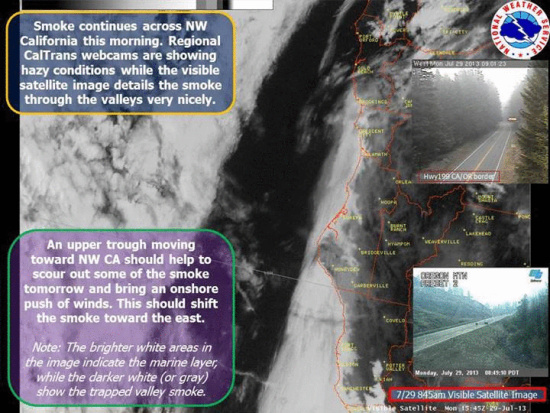
The US National Weather Service Eureka provided the above graphic. (Follow them on Facebook here.)
UPDATE: Press Release from the North Coast Unified Air Quality Management District added at the bottom.
According to the US National Weather Service out of Eureka, the smoke that is continuing to pour from fires in Oregon will blanket northwestern California this morning. (See graphic above for a visual on this. Bright white areas are coastal fogs while the darker grey areas are smoke.) The agency predicts that changes in the wind direction should shift the smoke eastward tomorrow.
Rick Martin, an air pollution control officer with Humboldt Air Quality 4433093 North Coast Unified Air Quality Management District explains that his agency is monitoring the situation. As of right now, he says, the impact of the smoke is “not at any levels people need to be concerned about. It isn’t at any level that will be harmful to people, not even people with respiratory illnesses.”
The image below shows the areas the smoke is covering and how thick it is throughout the day.

Animated image of smoke throughout California and surrounding areas over the course of the day. Note the time changing towards the top right. (From the Mendocino Air Quality Board.)
UPDATED with a Press Release from the NC Unified Air Quality Management District: (Thank you to Doug Bryan of the Southern Humboldt Fire Chiefs Association for pointing out that this information had been released.)
Lightning has ignited fires in Southern Oregon. Smoke from these fires is drifting into Northern California. The main fires generating the smoke Northern California is experiencing are the Labrador and the Douglas Complex wildfires. Depending on your proximity to the fires, and the weather conditions, people in Northern California will be affected.
Wildfire Smoke Public Service Announcement
Areas of wildfire smoke are predicted to impact the following regions:
Del Norte County
Humboldt County
Trinity County
If you [live] (or plan travel) in the regions listed above, please watch for Air Quality Alerts issued for specific locations. Alerts are issued when unhealthy or hazardous conditions exist.
Air Quality Alerts can be heard by calling the North Coast Unified Air Quality Management District’s 24-hour Air Quality Advisory Information hotline at 1-866-BURN-DAY (1-866-287-6329). They can also be accessed at the District’s website at www.ncuaqmd.org. For air quality announcements, stayed tuned to your local radio, newspaper, and television.
Concentrations of smoke may vary depending upon location, weather, and distance to the fire. Smoke from wildfires and structure fires contain harmful chemicals that can affect your health. Smoke can cause eye and throat irritation, coughing, and difficulty breathing. People who are at greatest risk of experiencing symptoms due to smoke include: those with respiratory disease (such as asthma), those with heart disease, young children, and older adults.
Children, the elderly, and those with respiratory disease or heart disease should stay indoors and avoid prolonged activity. All others should limit prolonged or heavy activity and time spent
outdoors. Even healthy adults can be affected by smoke. Seek medical help if you have symptoms that worsen or become severe.
If you can see, taste, or feel smoke, contact your local health department and/or primary healthcare provider. This is especially important if you have health concerns, are elderly, are pregnant, or have a child in your care.
Follow these general precautions to protect your health during a smoke event:
Minimize or stop outdoor activities, especially exercise
Stay indoors with windows and doors closed as much as possible
Do not run fans that bring smoky outdoor air inside – examples include swamp coolers, whole-house fans, and fresh air ventilation systems
Run your air-conditioner only if it does not bring smoke in from the outdoors. Change the standard air conditioner filter to a medium or high efficiency filter. If available, use the “re-circulate” or “recycle” setting on the unit
Do not smoke, fry food, or do other things that will create indoor air pollution
If you have lung disease (including asthma) or heart disease, closely monitor your health and contact your doctor immediately if you have symptoms that worsen.
Consider leaving the area until smoke conditions improve if you have:
repeated coughing
shortness of breath
difficulty breathing
wheezing
chest tightness or pain
palpitations
nausea
unusual fatigue
lightheadedness
For 24-hour Air Quality Advisory Information, call toll-free at
1-866-BURN-DAY (1-866-287-6329).
For further information, visit the District’s website at
www.ncuaqmd.org
Previously:
CLICK TO MANAGE